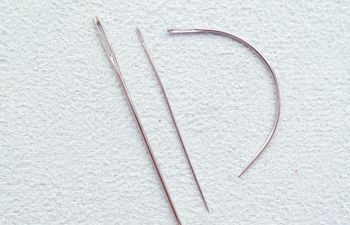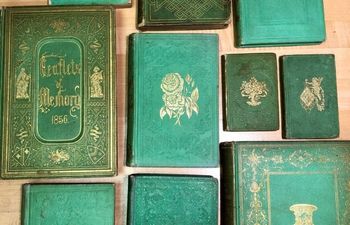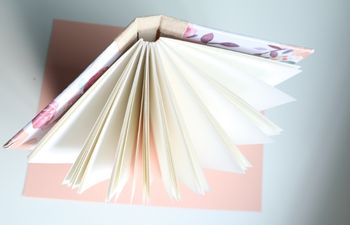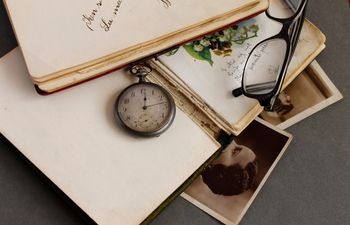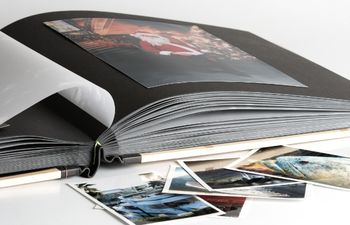Right now, there are two needle “flavors” in bookbinding: straight and curved. I’ll explain both so you’ll know how to choose the right bookbinding needle for your project.
Straight vs. Curved Bookbinding Needles
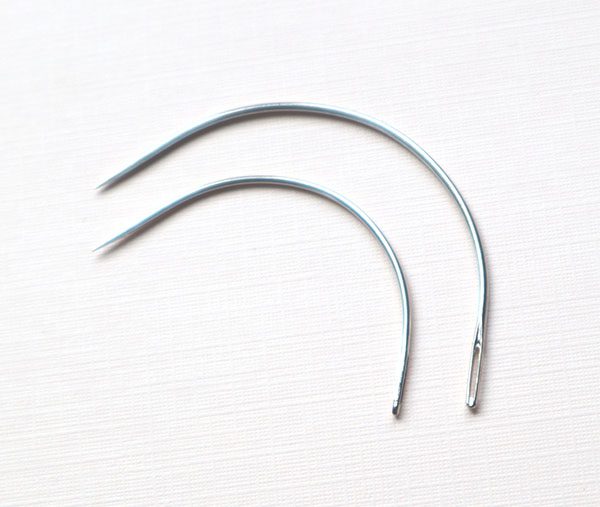
Believe it or not, needle shape makes a big difference when sewing certain types of bindings. It’s not technical, but more like whether or not the needle feels awkward in your hand while stitching.
When I started bookbinding, I always used a straight needle. It felt like the “right” thing to do. The more I tried different types of bindings, the more I noticed the needle didn’t flow as smoothly. I got pretty frustrated and even poked my finger a few times. After a while, I found I liked straight needles for certain bindings and curved for others.
Since we all have different sized hands and dexterity, there’s no right or wrong way to pick a needle shape. Just try them both and see what you like best.
Long vs. Short Bookbinding Needles
Using a long or short needle is another one of those “preference” things. If you’re struggling to manage a short needle while sewing, try moving up a 1/2″ (1.25cm) at a time until you find a good length.
If a binding asks you to sew through paper AND book board, go ahead and use a longer needle even if it bugs you. Small needles could get “lost” in the board and paper, which is just annoying.
Needle length is always measured in inches or cm, are made of steel and usually imported from England.
In bookbinding, I see a lot of 1-3/4″ and 2-1/2″ (measured from end to end) long needles.

Thick vs. Thin Bookbinding Needles
Needle thickness (gauge) can make your sewing holes bigger by accident, which can let more glue in. I talk about spine swell when picking thread size, but needle thickness is in the same camp. Needle thickness measures the diameter of the needle and is expressed as a number (#1, #3, etc.). The most common thicknesses used in bookbinding are #11, #15, #18 and #20.
As a general rule of thumb, pick a needle one size thicker than your thread.
Needle Eye Size & Shape
As a general rule of thumb, always choose a needle with an eye one size larger than the thickness of your thread.
Needle Eye Size
The “eye” of a needle is just the opening at the top where the thread is looped and tied. Bookbinding needles usually have pretty big eyes so we can use thicker threads.
Needle Eye Shape
There are two needle eye shapes you’ll see a lot: oval and circle.
Oval eye needles are the most common. Darner’s (or, darning) needles are longer, less sharp and have a long eye, making it easier to sew without getting hurt. That’s why we use Darner’s needles a lot in bookbinding.
Circle eye needles are specific to bookbinding (called Bookbinding needles) and have a polished eye to reduce wear on the thread. Quick tip – these are called bookbinding needles, not bookbinder’s needles. There is a slight difference (coming up next).
Sharp vs. Blunt Tip Bookbinding Needles
Fun fact: a true bookbinder’s needle is actually blunt. Crazy, eh?
Extra sharp tips are great when sewing through thick fabrics and leather, but they can be a pain if you accidentally poke yourself. We don’t need crazy sharp needles for books because we pre-pierce the paper with an awl before we sew.
A blunt-tip needle is commonly referred to as either a “Binder’s needle” or “ball-point needle.”
Darner’s needles are the sweet spot between “too sharp” and “blunt,” which is why we love ’em so much in the binding world.
Where to Buy Your Bookbinding Needles
I hope this information was helpful for you! Before I go, here are a few of my favorite places to buy needles:
Note: I also offer my Bookbinding Tools & Supplies Quick Start Guide if you’d like to know where to learn about and buy other small bookbinding tools.
- Darner’s & Bookbinder’s Needles – Talas Online and Colophon Book Arts
- Curved Needles – Talas Online and Colophon Book Arts
- Lineco sells needles on their website or Amazon
- After geeking out about needles, you might want to geek out about thread. I’ve made this possible for you:
Come see me on Instagram or Facebook if you have any questions needling at you (see what I did there?)
ALL my best,
Misty
